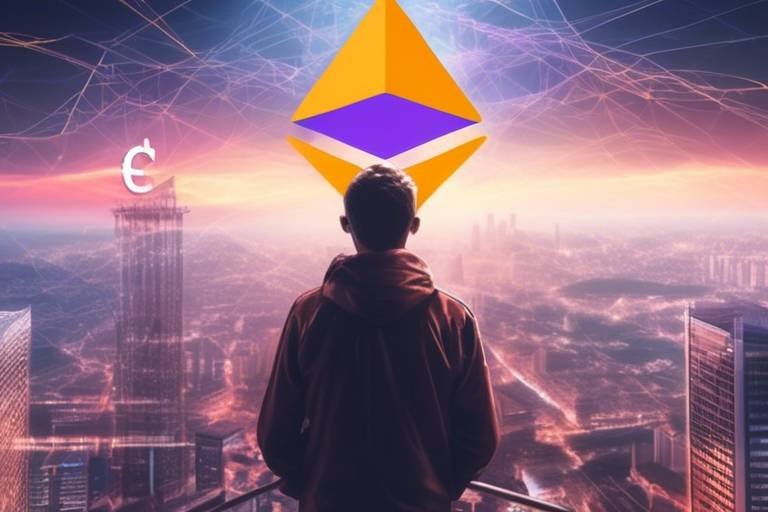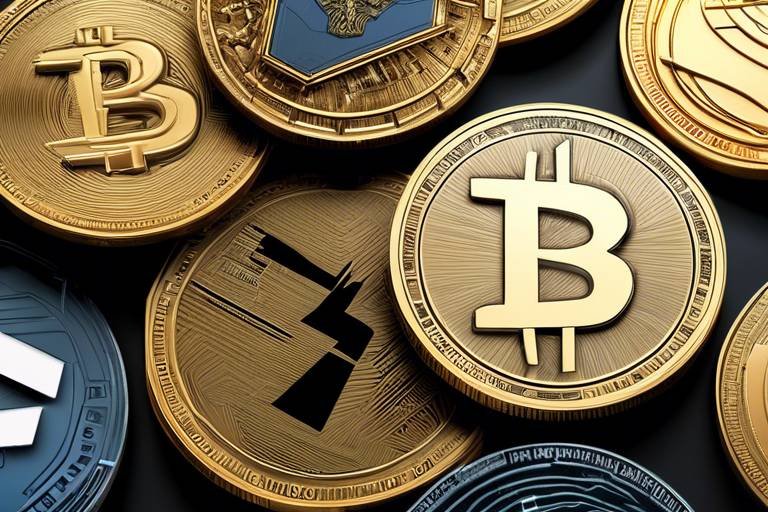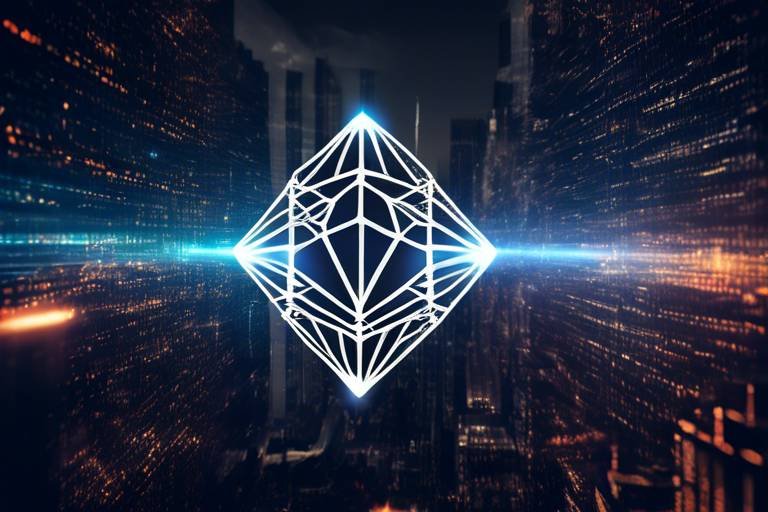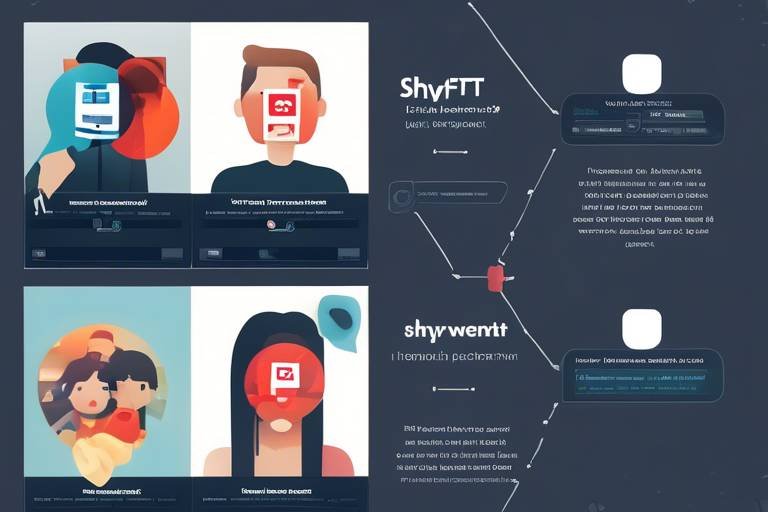Loopring - Layer 2 Protocol for Ethereum
Welcome to the fascinating world of Loopring! If you've ever felt the frustration of slow transaction times and high fees on the Ethereum network, you're not alone. Loopring is here to change that. This innovative Layer 2 scaling solution is designed to enhance Ethereum's transaction efficiency and reduce costs while ensuring security and decentralization through the cutting-edge technology known as zkRollups. Imagine a bustling highway where traffic flows smoothly without congestion; that's the kind of experience Loopring aims to provide for Ethereum users. In this article, we will dive deep into what Loopring is, how it works, and why it matters in the rapidly evolving blockchain landscape.
At its core, Loopring is a Layer 2 scaling protocol that leverages zkRollups to facilitate fast and cost-effective transactions on the Ethereum blockchain. But what does that really mean? Think of Loopring as a high-speed train running parallel to a crowded subway line. While the subway can get bogged down during rush hours, the train zips by, allowing passengers to reach their destinations quickly and efficiently. Loopring achieves this by bundling multiple transactions into a single batch, drastically reducing the load on the Ethereum network. This not only speeds up transaction times but also cuts down on gas fees, making it a win-win for everyone involved.
Now that we have a basic understanding of Loopring, let's delve into the mechanics of zkRollups. These are not just a fancy term; they are a pivotal technology that enables Loopring to function effectively. Essentially, zkRollups allow numerous transactions to be processed off-chain while still maintaining the integrity and security of the Ethereum blockchain. Imagine being able to send multiple postcards to different friends without having to wait in line at the post office each time. Instead, you drop them all off at once, and they get delivered efficiently. That’s the magic of zkRollups!
So, what are the key advantages of using zkRollups? Here are some of the standout benefits:
- Increased Throughput: zkRollups can handle thousands of transactions per second, far surpassing the capabilities of the Ethereum mainnet.
- Lower Fees: By reducing the number of transactions that need to be processed on-chain, users enjoy significantly lower gas fees.
- Enhanced Security: zkRollups utilize cryptographic proofs to ensure that all transactions are valid, keeping user assets safe and sound.
These advantages make zkRollups a compelling option for developers looking to build efficient and user-friendly applications on the Ethereum blockchain.
One of the most exciting aspects of Loopring's implementation of zkRollups is the remarkable scalability it offers. By enabling thousands of transactions per second, Loopring helps alleviate the limitations that have historically plagued the Ethereum network. Imagine a busy restaurant with a long wait time for tables; now picture that same restaurant expanding its seating capacity and hiring more staff to handle the influx of customers. That’s what Loopring does for Ethereum, ensuring that the network can accommodate more users without compromising on performance or speed.
In the world of blockchain, security is paramount. Loopring takes this seriously by ensuring that even though transactions are processed off-chain, user assets remain protected. The use of zkRollups means that every transaction is cryptographically verified before it’s finalized. It’s like having a bank vault that not only locks your valuables away but also requires multiple keys from different people to access it. This layered security approach ensures that your assets are safe, allowing users to transact with confidence.
Loopring's technology supports a wide array of applications, making it a versatile player in the blockchain ecosystem. From decentralized exchanges (DEXs) to payment solutions, the potential use cases are vast. For instance, DEXs can leverage Loopring to provide users with faster trades and lower fees, creating a more attractive trading environment. Similarly, payment solutions can benefit from Loopring's efficiency, allowing users to send and receive funds with minimal costs and delays. The possibilities are endless!
When it comes to Layer 2 solutions, Loopring is not alone. Other technologies, such as Optimistic Rollups and Plasma, are also vying for attention in the Ethereum scaling landscape. So how does Loopring stack up against these competitors? Let’s find out!
In this section, we will analyze the performance metrics of Loopring versus its competitors, focusing on transaction speed, cost-efficiency, and user experience. Loopring’s ability to handle thousands of transactions per second gives it a significant edge in speed. When it comes to costs, the lower gas fees associated with Loopring make it an attractive option for users. Ultimately, the best choice will depend on the specific needs of developers and users alike.
The success of Loopring is partly due to its active community and ecosystem. A strong community fosters innovation and support, which is crucial for any blockchain project. Developers, users, and enthusiasts come together to share ideas, provide feedback, and contribute to the growth of the Loopring protocol. This collaborative spirit is what drives Loopring forward, ensuring that it remains a competitive and relevant solution in the ever-evolving blockchain landscape.
1. What is Loopring?
Loopring is a Layer 2 scaling solution for Ethereum that utilizes zkRollups to enable fast and low-cost transactions.
2. How do zkRollups work?
zkRollups allow multiple transactions to be bundled together and processed off-chain, which reduces congestion on the Ethereum network.
3. What are the benefits of using Loopring?
The benefits include increased throughput, lower fees, and enhanced security for users.
4. How does Loopring compare to other Layer 2 solutions?
Loopring offers superior transaction speed and cost-efficiency compared to other solutions like Optimistic Rollups and Plasma.
5. Can I use Loopring for decentralized exchanges?
Absolutely! Loopring is designed to support decentralized exchanges and other applications in the blockchain ecosystem.

What is Loopring?
Loopring is a groundbreaking Layer 2 scaling protocol specifically designed to enhance the Ethereum blockchain's transaction capabilities. By leveraging a technology known as zkRollups, Loopring enables users to perform transactions that are not only faster but also significantly cheaper compared to traditional on-chain methods. Imagine trying to squeeze through a crowded subway during rush hour; Loopring acts like an express train, whisking you past the congestion and getting you to your destination with minimal delay and expense.
The core philosophy behind Loopring is to create a more efficient and user-friendly environment for decentralized finance (DeFi) applications. With the Ethereum network often facing congestion due to high demand, Loopring steps in to alleviate this pressure, ensuring that users can transact without the frustration of high gas fees or slow confirmation times. It’s like having a VIP pass to a concert; you get to enjoy the show without the hassle of long lines or hefty ticket prices.
One of the standout features of Loopring is its commitment to decentralization and security. Unlike some other solutions that may compromise these values for the sake of speed, Loopring ensures that all transactions remain secure and verifiable. This is achieved through the innovative use of cryptographic proofs, which allow for transactions to be bundled together and verified off-chain, while still maintaining the integrity of the Ethereum network.
To better understand the benefits of Loopring, consider the following key features:
- Fast Transactions: Loopring can handle thousands of transactions per second, making it ideal for high-volume applications.
- Low Fees: By processing transactions off-chain, Loopring significantly reduces the costs associated with Ethereum transactions.
- Security: Utilizing zkRollups, Loopring maintains high security standards, ensuring user funds are protected.
In summary, Loopring is not just another Layer 2 solution; it's a comprehensive approach to solving the inherent limitations of the Ethereum blockchain. By combining speed, cost-effectiveness, and security, Loopring is paving the way for a more accessible and efficient DeFi ecosystem. As we delve deeper into the technology behind Loopring, it becomes clear that this protocol is a game-changer for both developers and users alike.

How zkRollups Work
At the heart of Loopring's impressive capabilities lies the innovative technology known as zkRollups. But what exactly are zkRollups, and how do they work their magic on the Ethereum blockchain? To put it simply, zkRollups allow multiple transactions to be combined into a single batch, which is then processed off-chain. This bundling not only reduces the load on the Ethereum network but also significantly cuts down on transaction fees, making it a win-win for users.
Imagine a busy highway during rush hour, where every car represents a transaction. When all cars travel individually, traffic jams occur, and delays are inevitable. However, if we could group several cars into one large bus, the highway would be less congested, allowing for a smoother flow of traffic. This is essentially what zkRollups do—they take numerous transactions, compress them into a single proof, and submit that proof to the Ethereum blockchain. This process drastically enhances efficiency and speeds up transaction times.
One of the standout features of zkRollups is their use of zero-knowledge proofs. This cryptographic method allows for the validation of transactions without revealing sensitive information about them. Think of it like a magician performing a trick; the audience knows something amazing has happened, but they don’t see how it’s done. In the context of zkRollups, this means that while the transactions are verified off-chain, the details remain hidden, ensuring user privacy while maintaining security.
To illustrate how zkRollups function, let’s break down the process into a few key steps:
- Transaction Aggregation: Multiple transactions are collected and aggregated into a single batch.
- Proof Generation: A cryptographic proof is generated to validate the entire batch, ensuring that all transactions are legitimate.
- On-chain Submission: The proof is submitted to the Ethereum blockchain, along with a minimal amount of data needed to verify the transactions.
- State Updates: The state of the blockchain is updated based on the validated transactions, while the detailed information remains off-chain.
This method not only alleviates congestion on Ethereum but also significantly lowers the cost of transactions. Users can enjoy speedy transactions at a fraction of the cost they would typically incur on the main Ethereum network. With zkRollups, the Ethereum ecosystem can scale effectively, catering to a growing number of users and applications without compromising on security or decentralization.
Moreover, zkRollups are designed to be highly efficient. They can process thousands of transactions per second, which is a game changer in the blockchain space. This scalability allows developers to build more robust applications that can handle high volumes of transactions without a hitch. It's like upgrading from a bicycle to a high-speed train—suddenly, you can transport many more people in a fraction of the time!
In summary, zkRollups are a revolutionary technology that enhances the functionality of Ethereum by ensuring that transactions are faster, cheaper, and more secure. As we continue to explore the potential of Loopring and its applications, understanding zkRollups is essential for grasping how this protocol is paving the way for a more efficient blockchain ecosystem.
What are zkRollups?
zkRollups are a Layer 2 scaling solution that aggregates multiple transactions into a single proof, which is then submitted to the Ethereum blockchain, enhancing efficiency and reducing costs.
How do zkRollups improve transaction speed?
By bundling transactions and processing them off-chain, zkRollups significantly reduce the load on the Ethereum network, allowing for faster transaction confirmations.
Are zkRollups secure?
Yes, zkRollups utilize zero-knowledge proofs to ensure that transactions are validated without revealing sensitive information, maintaining both security and user privacy.

Benefits of zkRollups
The implementation of zkRollups within the Loopring protocol brings a plethora of benefits that significantly enhance the Ethereum experience. First and foremost, zkRollups allow for a substantial increase in transaction throughput. By bundling multiple transactions into a single proof, they minimize the amount of data that needs to be processed on-chain. This means that instead of each transaction clogging the Ethereum network, they can be efficiently processed in batches, leading to a smoother user experience.
Another major advantage of zkRollups is their ability to drastically lower transaction fees. In a world where gas prices can fluctuate wildly, zkRollups provide a more stable and economical solution. With the reduction in on-chain data, users can enjoy significantly lower costs when making transactions. This is particularly beneficial for users engaging in frequent trading or microtransactions, where every penny counts.
Moreover, security remains a top priority in the blockchain realm, and zkRollups excel in this area as well. They utilize cryptographic proofs to ensure that all transactions are valid without revealing the individual transaction details. This means that users can enjoy the benefits of off-chain processing while still maintaining the integrity and security of their assets. In essence, zkRollups strike a perfect balance between scalability and security, making them a compelling choice for developers and users alike.
To summarize the key benefits of zkRollups, consider the following:
- Increased Throughput: Capable of handling thousands of transactions per second.
- Lower Fees: Reduced costs for users compared to traditional on-chain transactions.
- Enhanced Security: Cryptographic proofs ensure transaction validity without compromising user data.
As we delve deeper into the world of Layer 2 solutions, it becomes clear that zkRollups are not just a temporary fix for Ethereum's scalability issues; they represent a long-term solution that can adapt and grow with the network. This makes Loopring a standout option for those looking to harness the power of Ethereum while enjoying the benefits of modern technology.

Scalability Improvements
When it comes to blockchain technology, scalability is a hot topic, and for good reason! As the Ethereum network continues to grow, the need for faster and more efficient transaction processing becomes critical. That’s where Loopring shines. By leveraging the power of zkRollups, Loopring is able to significantly enhance the scalability of Ethereum, allowing it to handle thousands of transactions per second. Imagine a highway that suddenly expands to accommodate a rush hour of vehicles without any traffic jams—this is what Loopring does for Ethereum's transaction throughput.
One of the standout features of Loopring is its ability to batch multiple transactions into a single proof. This means that instead of each transaction being processed individually on the Ethereum mainnet, they are bundled together, which drastically reduces the load on the network. The result? A smoother, faster experience for users. To put it simply, Loopring acts like a high-speed train, efficiently transporting a large number of passengers (transactions) with minimal stops along the way.
Moreover, the scalability improvements provided by Loopring aren’t just about speed; they also translate into lower costs for users. With fewer transactions needing to be processed on-chain, the overall gas fees drop significantly. Users can enjoy the benefits of quick transactions without the hefty price tag that often comes with Ethereum transactions. In a world where every penny counts, this is a game-changer!
To give you a clearer picture, let’s look at a comparative table that outlines the scalability metrics of Loopring versus traditional Ethereum transactions:
| Metric | Loopring | Ethereum Mainnet |
|---|---|---|
| Transactions per Second (TPS) | Up to 2,000 | 15-30 |
| Average Transaction Fee | Low (cents) | Varies (dollars during peak times) |
| Confirmation Time | Seconds | Minutes |
As you can see, the numbers speak for themselves! With Loopring, users can expect a remarkable enhancement in both speed and cost-effectiveness. This makes Loopring not only a viable option for developers looking to build decentralized applications but also an attractive choice for everyday users who want to maximize their Ethereum experience.
In conclusion, Loopring’s implementation of zkRollups is a revolutionary step towards solving the scalability issues that have plagued Ethereum. By providing a solution that allows for higher throughput, lower fees, and a seamless user experience, Loopring is paving the way for a more efficient blockchain ecosystem. It’s like having a supercharged engine under the hood of your favorite vehicle—everything just runs smoother and faster!
- What is Loopring? Loopring is a Layer 2 scaling protocol that enhances Ethereum's transaction efficiency using zkRollups.
- How does Loopring improve scalability? Loopring batches multiple transactions into a single proof, significantly reducing congestion and costs.
- What are zkRollups? zkRollups are a technology that allows for off-chain transaction processing while maintaining security on the Ethereum network.
- Can Loopring handle high transaction volumes? Yes, Loopring can handle up to 2,000 transactions per second, making it highly scalable.

Enhanced Security Features
When it comes to blockchain technology, security is not just an option; it's a necessity. Loopring takes this principle to heart, leveraging the power of zkRollups to ensure that transactions remain secure while being processed off-chain. But how exactly does Loopring maintain this high level of security? Let's dive into the details.
First and foremost, zkRollups utilize zero-knowledge proofs, a cryptographic method that allows one party to prove to another that a statement is true without revealing any specific information about that statement. This means that while Loopring can verify transactions without exposing sensitive data, users can feel confident knowing their information is safe. Imagine sending a secret note to a friend; you want them to know the message is real, but you don't want them to read it. That's the essence of zero-knowledge proofs!
Moreover, Loopring's architecture ensures that users retain full control over their assets. Unlike some centralized exchanges where your funds are held by a third party, Loopring allows you to maintain ownership of your assets throughout the transaction process. This decentralization is a significant advantage, as it minimizes the risk of hacks or mismanagement that can occur when funds are pooled in a single location.
Another layer of security comes from the fact that Loopring operates on the Ethereum blockchain, which is known for its robust security features. The Ethereum network itself has undergone extensive testing and development, making it one of the most secure blockchains available. By utilizing Ethereum's security, Loopring benefits from its established reputation and infrastructure, further enhancing its own security measures.
In addition to these features, Loopring employs a system of smart contracts that are rigorously audited. These contracts dictate the rules of engagement within the Loopring protocol, ensuring that all transactions are executed as intended without the possibility of manipulation. Think of smart contracts as the referees of a game; they ensure that the rules are followed, and any foul play is immediately addressed.
To summarize, Loopring's enhanced security features can be encapsulated in the following key points:
- Zero-Knowledge Proofs: Protects user data while ensuring transaction validity.
- Decentralization: Users maintain control over their assets, minimizing risks associated with centralized exchanges.
- Utilization of Ethereum’s Security: Leverages the robust security measures of the Ethereum blockchain.
- Audited Smart Contracts: Ensures that all transactions are executed under strict rules, preventing manipulation.
In conclusion, Loopring's approach to security is multifaceted, combining innovative technology with established practices to create a safe environment for users. By prioritizing security, Loopring not only enhances trust among its users but also positions itself as a formidable player in the Layer 2 ecosystem, making it an attractive option for developers and users alike.
What are zkRollups?
zkRollups are a Layer 2 scaling solution that allows multiple transactions to be bundled together, significantly reducing congestion on the Ethereum network while maintaining security through zero-knowledge proofs.
How does Loopring ensure the security of user assets?
Loopring utilizes zero-knowledge proofs, decentralized asset control, and audited smart contracts, all built on the secure Ethereum blockchain, to protect user assets from potential threats.
Can I trust Loopring with my funds?
Yes, Loopring's design allows users to retain control over their funds, and its security measures are robust, making it a trustworthy platform for transactions.

Use Cases for Loopring
Loopring is not just a theoretical concept; it has practical applications that are making waves in the blockchain ecosystem. One of the most prominent use cases is in the realm of decentralized exchanges (DEXs). With the rise of digital assets, the need for efficient and cost-effective trading solutions has skyrocketed. Loopring enables users to trade tokens directly from their wallets without the need for a centralized intermediary, ensuring that they maintain control over their assets at all times. This is a game-changer in a world where security and privacy are paramount.
Another exciting use case for Loopring lies in payment solutions. Imagine sending money to a friend across the globe in a matter of seconds, with minimal fees and without the hassles of traditional banking systems. Loopring's ability to process thousands of transactions per second makes it an ideal candidate for peer-to-peer payments, particularly in regions where banking infrastructure is lacking. The efficiency and speed of Loopring can transform how we think about money transfers, making them as easy as sending a text message.
Moreover, Loopring is also paving the way for gaming and NFTs (Non-Fungible Tokens). As the gaming industry continues to integrate blockchain technology, Loopring provides a scalable solution for in-game transactions. Players can buy, sell, and trade in-game assets seamlessly, with the assurance that their transactions are secure and cost-effective. This opens up a whole new world of possibilities for game developers and players alike, where digital ownership and asset trading become a core part of the gaming experience.
To further illustrate the versatility of Loopring, here’s a quick overview of its key use cases:
- Decentralized Exchanges: Facilitating secure and efficient trading of cryptocurrencies.
- Payment Solutions: Enabling fast and low-cost transactions for global payments.
- Gaming and NFTs: Supporting in-game asset transactions and ownership transfers.
As we can see, Loopring's technology is not just about improving transaction speeds; it's about creating a robust ecosystem that empowers users and developers. The potential applications are vast, and as more people become aware of its capabilities, we can expect to see even more innovative uses emerge. The future is bright for Loopring, and it’s exciting to think about how it will shape the landscape of blockchain technology.
Q1: What is Loopring?
A1: Loopring is a Layer 2 scaling solution for Ethereum that uses zkRollups to enable fast, low-cost transactions while maintaining security and decentralization.
Q2: How does Loopring enhance transaction efficiency?
A2: By bundling multiple transactions together through zkRollups, Loopring significantly reduces congestion on the Ethereum network, allowing for quicker and cheaper transactions.
Q3: What are some practical applications of Loopring?
A3: Loopring can be used for decentralized exchanges, payment solutions, and gaming/NFT transactions, showcasing its versatility in the blockchain ecosystem.
Q4: How does Loopring compare to other Layer 2 solutions?
A4: Loopring offers unique advantages such as increased transaction speed and lower fees compared to other Layer 2 solutions like Optimistic Rollups and Plasma.
Q5: Is Loopring secure?
A5: Yes, Loopring maintains high security standards even while processing transactions off-chain, ensuring that user assets are protected.

Loopring vs. Other Layer 2 Solutions
When it comes to scaling Ethereum, Loopring stands out among a myriad of Layer 2 solutions, but how does it truly compare to others like Optimistic Rollups and Plasma? Each of these technologies has its own unique strengths and weaknesses, and understanding these differences can help users and developers make informed choices. Loopring, with its innovative use of zkRollups, offers a compelling alternative that focuses on transaction speed, cost-efficiency, and user security.
First off, let’s break down what sets Loopring apart. While Optimistic Rollups rely on the assumption that transactions are valid until proven otherwise, which can lead to potential delays in transaction finality, Loopring’s zkRollups provide immediate confirmation of transaction validity through cryptographic proofs. This means users can enjoy faster transactions without the worry of waiting for a challenge period, which is a common drawback in Optimistic Rollups.
Moreover, when we look at transaction costs, Loopring shines brightly. The fees associated with using Loopring are generally lower than those found in other Layer 2 solutions. This is primarily because zkRollups aggregate multiple transactions into a single proof, reducing the overall gas fees incurred on the Ethereum mainnet. For users, this translates into a more cost-effective way to interact with the Ethereum blockchain, especially for those who frequently engage in trading or other high-volume activities.
To put this into perspective, consider the following comparison table:
| Feature | Loopring | Optimistic Rollups | Plasma |
|---|---|---|---|
| Transaction Speed | Fast (instant finality) | Moderate (depends on challenge period) | Variable (depends on exit time) |
| Transaction Fees | Low | Moderate | Can be high |
| Security Model | Strong (zero-knowledge proofs) | Moderate (relies on fraud proofs) | Strong (but complex exit mechanisms) |
In addition to transaction speed and costs, security is another crucial aspect where Loopring excels. The use of zkRollups not only enhances transaction throughput but also fortifies security by ensuring that all transactions are validated off-chain before being committed to the Ethereum blockchain. This means that user assets are safeguarded against potential vulnerabilities that can arise in other Layer 2 solutions, especially those relying on optimistic assumptions.
However, it’s essential to acknowledge that no solution is without its drawbacks. While Loopring offers significant advantages, it may not be the best fit for every use case. For instance, some developers might prefer the flexibility that Optimistic Rollups provide for complex smart contracts, which can be a limitation in Loopring’s current architecture. Similarly, Plasma can offer unique scalability solutions for specific applications, although it comes with its own set of complexities.
In conclusion, the choice between Loopring and other Layer 2 solutions ultimately depends on the specific needs and goals of the user or developer. If speed, low fees, and enhanced security are top priorities, Loopring is undeniably a strong contender. However, for those requiring flexibility in smart contract execution or unique scalability features, exploring alternatives like Optimistic Rollups or Plasma may be worthwhile. The evolving landscape of Ethereum scaling solutions continues to grow, and understanding these differences will empower users to make the best decisions for their blockchain interactions.
1. What is Loopring?
Loopring is a Layer 2 scaling protocol designed to enhance transaction speed and reduce costs on the Ethereum blockchain using zkRollups technology.
2. How do zkRollups work?
zkRollups bundle multiple transactions into a single proof, allowing for faster transaction processing and lower fees while maintaining security.
3. How does Loopring compare to other Layer 2 solutions?
Loopring generally offers faster transaction speeds, lower fees, and enhanced security compared to solutions like Optimistic Rollups and Plasma.
4. What are the main benefits of using Loopring?
The main benefits include increased transaction throughput, reduced costs, and strong security measures that protect user assets.
5. Can Loopring be used for decentralized exchanges?
Yes, Loopring is well-suited for decentralized exchanges, providing a fast and cost-effective way to trade assets on the Ethereum blockchain.

Performance Comparison
When we dive into the world of Layer 2 solutions, performance becomes a crucial factor that can make or break a protocol's success. Loopring, with its innovative use of zkRollups, stands out in terms of transaction speed, cost-efficiency, and user experience. But how does it stack up against its competitors? Let's break it down.
First off, let's talk about transaction speed. Loopring can handle thousands of transactions per second (TPS), significantly outpacing many other Layer 2 solutions. For instance, while traditional Ethereum transactions might take several minutes during peak times, Loopring ensures that users can complete their transactions in seconds. This is primarily due to the way zkRollups bundle multiple transactions into a single proof, which is then validated on the Ethereum main chain.
Now, when it comes to cost-efficiency, Loopring shines even brighter. The fees associated with transactions on Loopring are remarkably low, often just a fraction of a cent. This is a game-changer for users, especially when compared to other Layer 2 solutions like Optimistic Rollups, where fees can still be relatively high during network congestion. In fact, users can save up to 90% on transaction fees when opting for Loopring over standard Ethereum transactions.
To give you a clearer picture, here’s a quick comparison table:
| Layer 2 Solution | Transaction Speed (TPS) | Average Cost per Transaction |
|---|---|---|
| Loopring | Up to 2,000+ | ~$0.01 |
| Optimistic Rollups | Up to 100+ | ~$0.10 |
| Plasma | Varies, generally lower | ~$0.05 |
Finally, let's discuss user experience. Loopring has designed its platform to be intuitive and user-friendly, making it accessible to both seasoned crypto enthusiasts and newcomers alike. The seamless integration with existing wallets and applications enhances the overall experience, allowing users to transact without the steep learning curve associated with some other Layer 2 solutions. In contrast, solutions like Optimistic Rollups may require users to wait for transaction confirmations, which can lead to frustration during high-traffic periods.
In summary, when we compare Loopring to its competitors, it clearly emerges as a leader in performance metrics. With its exceptional transaction speed, ultra-low fees, and user-centric design, it presents a compelling case for anyone looking to leverage the benefits of Ethereum without the usual drawbacks. As the blockchain space continues to evolve, Loopring's commitment to efficiency and user satisfaction sets a high bar for other Layer 2 solutions to aspire to.
- What is Loopring? Loopring is a Layer 2 scaling protocol for Ethereum that aims to provide fast and low-cost transactions using zkRollups technology.
- How does Loopring achieve low transaction fees? By bundling multiple transactions into a single proof, Loopring significantly reduces the cost of processing transactions on the Ethereum network.
- Is Loopring secure? Yes, Loopring maintains a high level of security by processing transactions off-chain while ensuring that user assets are protected through zkRollups.
- Can I use Loopring for decentralized exchanges? Absolutely! Loopring supports various applications, including decentralized exchanges and payment solutions.

Community and Ecosystem Support
The success of Loopring is not solely attributed to its innovative technology but also significantly relies on its vibrant community and robust ecosystem. In the world of blockchain, community engagement plays a crucial role in the development and adoption of protocols, and Loopring is a prime example of this phenomenon. The community surrounding Loopring is composed of passionate developers, enthusiastic users, and dedicated investors who actively contribute to the protocol's growth and sustainability.
One of the key components of Loopring's community is its active participation in forums, social media platforms, and development discussions. For instance, platforms like Discord and Telegram serve as hubs for communication where users can share insights, ask questions, and collaborate on various projects. This level of interaction fosters a sense of belonging and encourages knowledge sharing, which is essential for any open-source project. Moreover, the Loopring team frequently engages with the community, providing updates and gathering feedback to enhance the protocol continually.
In addition to user engagement, Loopring benefits from a diverse ecosystem of partners and developers. This ecosystem includes decentralized finance (DeFi) applications, exchanges, and wallets that integrate Loopring's technology to offer enhanced services. For example, decentralized exchanges (DEXs) built on Loopring allow users to trade assets with minimal fees and rapid transaction times, which are pivotal in today’s fast-paced trading environment. The collaboration with various projects not only amplifies Loopring's reach but also solidifies its position within the Ethereum landscape.
Furthermore, Loopring has established a developer grant program aimed at incentivizing developers to build on its platform. This initiative is designed to attract talent and innovative projects that can leverage Loopring’s zkRollups technology. By providing financial support and resources, Loopring ensures that the ecosystem continues to thrive and evolve. This approach not only enhances the protocol's capabilities but also contributes to a more dynamic and diverse range of applications available to users.
To illustrate the diverse support Loopring receives, consider the following table that highlights some of the key community initiatives and partnerships:
| Initiative/Partner | Description |
|---|---|
| Developer Grant Program | Supports developers building on Loopring with funding and resources. |
| Community Forums | Platforms like Discord and Telegram for user interaction and support. |
| Partnerships with DEXs | Integration with decentralized exchanges to enhance trading experiences. |
| Educational Resources | Workshops and webinars to educate users and developers about Loopring. |
In conclusion, the community and ecosystem support surrounding Loopring are pivotal for its ongoing success and innovation. By fostering a collaborative environment, Loopring not only enhances its technological capabilities but also builds a strong foundation for future growth. The active participation of users and developers ensures that Loopring remains at the forefront of the Layer 2 scaling solutions for Ethereum, continuously adapting to the ever-changing landscape of blockchain technology.
- What is Loopring?
Loopring is a Layer 2 scaling protocol for Ethereum that uses zkRollups to facilitate fast and low-cost transactions. - How does Loopring ensure security?
Loopring maintains security through zkRollups, which allow transactions to be processed off-chain while safeguarding user assets. - What are the benefits of zkRollups?
They offer increased throughput, lower fees, and enhanced security, making them an attractive option for developers and users. - How can I get involved with the Loopring community?
You can join the Loopring community through platforms like Discord and Telegram, where you can participate in discussions and collaborate on projects.
Frequently Asked Questions
-
What is Loopring and how does it work?
Loopring is a Layer 2 scaling protocol designed to enhance the Ethereum blockchain's transaction efficiency. It operates using a technology called zkRollups, which bundles multiple transactions together, reducing network congestion and significantly lowering transaction costs. This means users can enjoy faster and cheaper transactions without compromising security.
-
What are zkRollups and why are they important?
zkRollups are a crucial technology behind Loopring that allows for the aggregation of numerous transactions into a single proof. This approach not only boosts transaction throughput but also keeps fees minimal. By processing transactions off-chain and only submitting the proof to the Ethereum mainnet, zkRollups help alleviate congestion while ensuring that user assets remain secure.
-
What are the benefits of using Loopring?
Using Loopring comes with several advantages, including:
- Increased Throughput: Loopring can handle thousands of transactions per second, making it highly scalable.
- Lower Fees: Transaction costs are significantly reduced, making it affordable for users.
- Enhanced Security: Loopring ensures that user assets are protected even when transactions are processed off-chain.
-
How does Loopring compare to other Layer 2 solutions?
When compared to other Layer 2 solutions like Optimistic Rollups and Plasma, Loopring stands out primarily due to its unique zkRollup technology, which offers superior transaction speeds and lower costs. While other solutions may prioritize different aspects, Loopring's focus on security and user experience makes it a compelling choice for developers and users alike.
-
What are some practical use cases for Loopring?
Loopring supports a variety of applications, including:
- Decentralized exchanges (DEXs) that require fast and secure trading.
- Payment solutions that benefit from low transaction fees.
- Any application that demands high throughput and security on the Ethereum network.
-
How does the community support Loopring?
The success of Loopring is largely attributed to its vibrant community and ecosystem. Community members contribute to development, provide support, and help drive the protocol's growth. This collaborative environment fosters innovation and ensures that Loopring remains at the forefront of Layer 2 solutions.



















